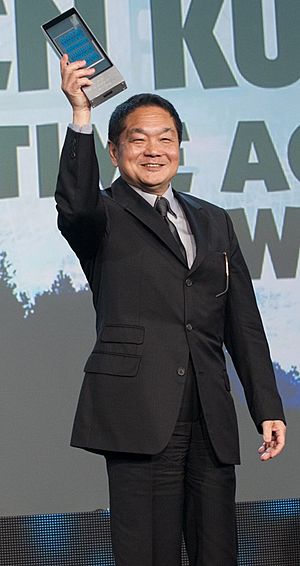Ken Kutaragi facts for kids
Quick facts for kids
Ken Kutaragi
|
|
|---|---|

Kutaragi with his Lifetime Achievement Award at the Game Developers Choice Awards 2014
|
|
| Born | 2 August 1950 Kōtō, Tokyo, Japan
|
| Alma mater | University of Electro-Communications |
| Occupation | Engineering technologist, businessman |
| Known for | PlayStation, Sony Interactive Entertainment, Cellius |
| Children | 1 |
Ken Kutaragi (久夛良木 健, Kutaragi Ken, born 2 August 1950) is a Japanese engineer and businessman. He is often called "The Father of the PlayStation" because he led the creation of the first PlayStation console and its later versions. He used to be the head of Sony Computer Entertainment (SCE), which is Sony's video game part. He left Sony in 2007, not long after the PlayStation 3 was released.
Before his work on PlayStation, Kutaragi also designed the sound processor for the Super Nintendo Entertainment System. At Sony, he helped create a special chip called a VLSI chip. This chip worked with the PlayStation 1's main processor to handle all the graphics.
Early Life and Education
Ken Kutaragi was born in Tokyo, Japan, in 1950. His parents owned a small printing business. They encouraged him to explore how machines worked, and he often helped out at their plant after school. Besides working, Kutaragi was a very good student.
From a young age, Kutaragi loved to "tinker" with things. He would often take toys apart to see how they worked instead of just playing with them. This curiosity grew as he got older, leading him to learn a lot about electronics. His passion for electronics led him to study at the University of Electro-Communications. He earned a degree in Electronics there in the 1970s.
Right after finishing college, Kutaragi started working for Sony in their digital research labs in the mid-1970s. He quickly became known as a great problem-solver and a forward-thinking engineer. He worked on many successful projects, including early liquid crystal displays (LCDs) and digital cameras.
Creating the PlayStation
In 1983, Kutaragi saw his two-year-old daughter playing a Famicom and realized how much potential video games had. So, when Nintendo needed a sound chip for their new 16-bit system, Kutaragi took the job. He worked secretly to design the chip, called the SPC700. At that time, Sony's leaders were not interested in video games. When they found out about his secret work with Nintendo, they were very upset. Only with the help of Sony's CEO, Norio Ohga, was Kutaragi able to finish the chip and keep his job.
Even though Kutaragi was working on games, many at Sony still thought video games were just a passing trend. Despite this, Kutaragi convinced Ohga to work with Nintendo on a CD-ROM add-on for the Super NES. This add-on would also come with a Sony console that could play both Super NES cartridges and CD games. This project was called the "Play Station".
However, the partnership between Sony and Nintendo ended because of disagreements over how to share the profits. But Kutaragi and Sony kept working on their own console. Kutaragi wanted to use Sony's newest technology to create the most powerful home console available. He also noticed that Nintendo mainly focused on games for children. He wanted Sony's console to appeal to older players, as he felt this market was not yet fully explored. Kutaragi later remembered staying up all night working on the console design because the work was so exciting. Even though other Sony executives thought it was a big risk, Kutaragi had Ohga's support again. Several years later, Sony released the original PlayStation. Its huge success led him to lead the development of the next consoles, the PlayStation 2 and PlayStation 3.
PlayStation's Success
The PlayStation series became very successful, making Sony Computer Entertainment the most profitable part of Sony. Even though Sony was new to the console market, competing against experienced companies like Nintendo and Sega, the first PlayStation became the most popular console of its time. The PlayStation 2 continued Sony's lead in the next generation of consoles. At one point, it held 65% of the market, selling 100 million units. Kutaragi was praised by many technology and business magazines for this success. He was even named one of the 100 most influential people of 2004 by TIME magazine.
In 1997, Kutaragi became the CEO of Sony Computer Entertainment America and moved to California. He was seen as a strong candidate to become the next Sony president. He had a close relationship with Ohga. Ohga's successor, Nobuyuki Idei, promoted Kutaragi to Deputy Executive President and Vice-Chairman in 2003.
On November 30, 2006, Kazuo Hirai took over as president of Sony Computer Entertainment. Kutaragi was promoted to chairman of SCEI and kept his role as chief executive officer of the group. On April 26, 2007, it was announced that Kutaragi would retire from active management and become Honorary Chairman. Hirai then took over his position and later became president and CEO of Sony. On June 29, 2011, Sony announced that Kutaragi had stepped down as honorary chairman of SCEI. He had already stepped away from managing the business he created in 2007. He has remained at Sony as a senior technology advisor.
Today, Ken Kutaragi is the president and CEO of Cyber AI Entertainment, Inc. He also serves on the boards of several other companies, including Kadokawa Group Holdings, Nojima Corporation, and Rakuten. In 2009, he became a visiting professor at Ritsumeikan University. In 2020, Kutaragi became the CEO of Ascent Robotics, an AI and robotics startup in Tokyo, after being on its Board of Directors since 2018.
See also
 In Spanish: Ken Kutaragi para niños
In Spanish: Ken Kutaragi para niños

